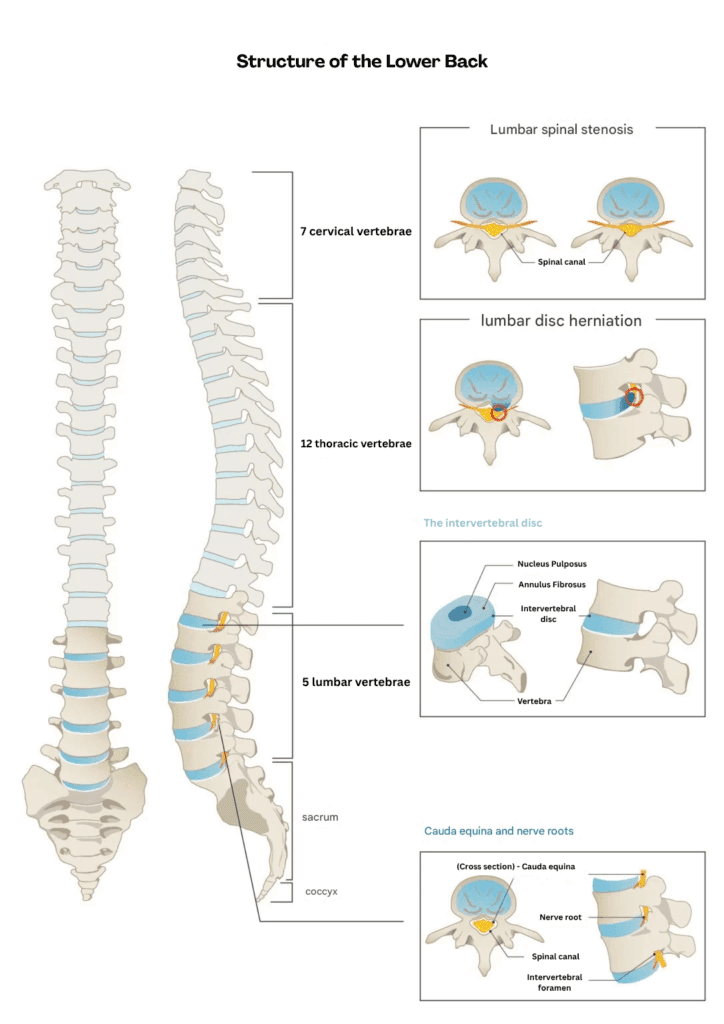Column What is Spinal Canal Stenosis? Symptoms, Causes, and Treatments Explained by a Back Pain Specialist 🩺
July 11, 2022
What Is Spinal Canal Stenosis?
Spinal stenosis refers to a condition where the spinal canal—the opening that runs through the spine and protects the spinal cord—becomes compressed or stenosed (i.e. narrowed) due to a variety of factors.
The following diagram illustrates the structure of the spine and spinal canal, helping to visualize how spinal canal stenosis develops.

Key Symptoms That May Indicate Spinal Canal Stenosis
Two symptoms are most commonly associated with spinal stenosis:
① Intermittent Claudication
This is the most characteristic symptom. A person can walk for some distance, but their legs gradually become tired, numb, or weak, forcing them to stop. After resting briefly, they can resume walking. Another distinctive feature is that walking while bending forward at the waist (such as when pushing a shopping cart) often allows you to walk relatively longer distances with less discomfort.
② Sciatica
Pain and numbness often radiate from the lower back through the buttocks and thighs, sometimes extending to the calves or feet.
Symptoms can include:
- A sharp, electric shock-like pain, or numbness.
- Tightness in the calves.
- Coldness or a burning sensation.
- Leg fatigue or heaviness.
These symptoms are particularly common in middle-aged and elderly individuals. In severe cases, the pain can become so intense that the person cannot walk or cannot stand up from a chair.
If you experience these symptoms, it is highly recommended to consult a medical institution for a diagnosis.
Main Causes of Spinal Canal Stenosis
Medically, spinal stenosis is primarily caused by the following three factors:
- Compression of the spinal canal by deformed or protruding intervertebral discs
- Compression of the spinal canal due to vertebral deformation (bone spurs/osteophytes)
- Compression of the spinal canal due to a thickening (hypertrophy) of the ligamentum flavum
These changes narrow the spinal canal, compressing the spinal nerves and causing pain or numbness.

These changes narrow the spinal canal, compressing the spinal nerves and causing pain or numbness.
Additionally, the following mechanisms may also contribute to symptoms:
- Inflammation caused by contact between the nucleus pulposus components of a degenerated disc and the spinal cord/nerves.
- Inflammation in the facet joints due to the strain of supporting the spinal misalignment.
- Inflammation in the back muscles and fascia as they compensate for spinal imbalance
How Spinal Canal Stenosis Is Diagnosed
The above structural and inflammatory changes can all be clearly visualized with MRI imaging.
While X-rays and CT scans are excellent for evaluating bone structures, MRI is superior for detecting soft tissue abnormalities, such as disc degeneration and nerve inflammation.
A thorough medical interview and physical assessment are also essential to understand the patient’s pain and numbness patterns before reaching a diagnosis.
Treatment Options for Spinal Canal Stenosis
Treatment approaches can be broadly divided into four categories:
Below is an overview of each approach.
1.Conservative Treatments
This is the first-line approach offered in most clinics. Common treatments include:
- Physical therapy (rehabilitation)
- Nerve block injections
- Medication (anti-inflammatory or pain relief)
- Orthotic support such as back braces
- Heat therapy
Each treatment has its own merits, which will be developped in later blog articles.
2.Surgery
Surgery is often proposed if conservative therapy fails to provide improvement after 3 to 6 months and the patient’s condition suggests a favorable surgical outcome.
Common surgical procedures include:
Decompression Surgeries (Laminectomy Types):
- Laminectomy
- Spinous Process-Splitting Laminectomy (SPSL)
- Endoscopic Lumbar Laminectomy
- Full-Endoscopic Lumbar Decompression
Spinal Fusion Surgeries:
- Minimally Invasive Transforaminal Lumbar Interbody Fusion (MIS-TLIF)
- Lateral Lumbar Interbody Fusion (LLIF)
- Posterior Lumbar Interbody Fusion (PLIF)
- Endoscopic Lumbar Interbody Fusion (ELIF)
Laminoplasty:
- Micro Endoscopic Laminoplasty (MEL)
- Percutaneous Endoscopic Laminoplasty (PEL)
While surgery offers a high probability of short-term symptom improvement by physically removing or fixing the causative area, our clinic believes the long-term risk of recurrence is high.
This is because surgery often fails to address the fundamental cause of spinal stenosis, which is disc damage (it can only remove the deformed disc or replace it with a cage).
3. Advanced Medical Treatments
This category includes treatments that focus on repairing and regenerating the intervertebral disc, which is the root cause of spinal stenosis.
The Cellgel Method
Our clinic (ILC International Lumbago Clinic) has been pioneering the introduction of this advanced low back pain treatment in Japan.
🔗 Learn more about the Cellgel Method here
4. Other Alternative Therapies
These treatments are sometimes used and may offer some effect, but they often offer limited medical evidence:
- Massages
- Chiropractic adjustment
- Acupuncture and Moxibustion
This article was written by the administrative Director of the Clinic: Tadaaki MINOWA



